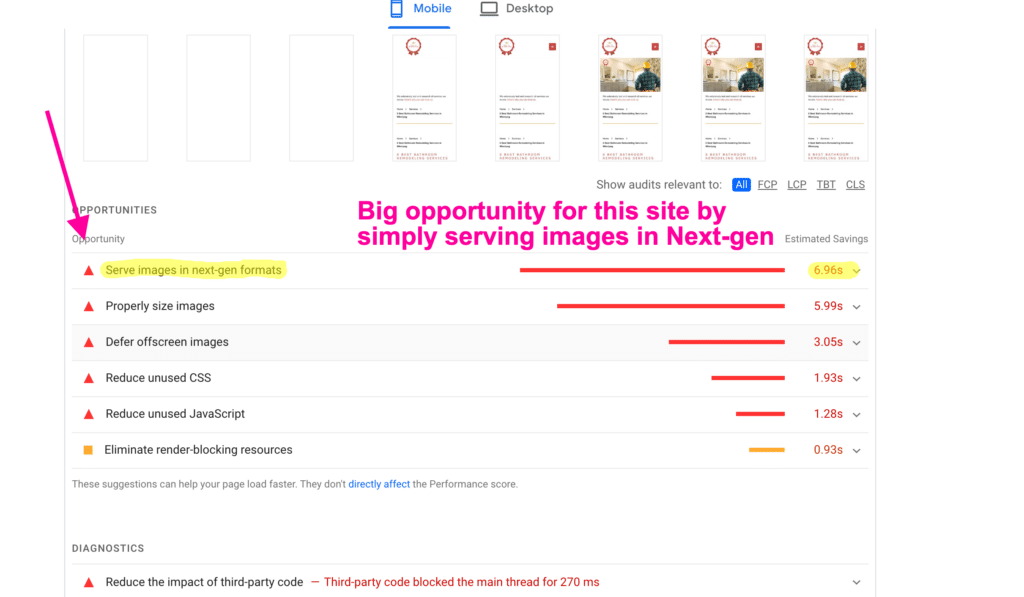Improving Core Web Vitals and getting a ‘pass’ as opposed to a ‘fail’ is one of the few search engine ranking factors that Google explicitly provides us with and we can directly fix, optimize and maintain, so for that reason I have made it a priority to maintain a pass on all my websites; both local business sites and content sites.
In this post, I will be covering the simple step-by-step process to optimizing the Core Web Vitals of a WordPress site. Most sites can be fixed rather easily following this methodology. Moving in this order ensures your maximizing the return on your investment (in most cases time).
The Metric To Focus On
When it comes to this page speed stuff, there’s no shortage of page speed analysis tools that will over whelm you and make things overly complex. Some page speed tools will give you different ratings and recommendations. Even within the Google Ecosystem you’ll find inconsistencies such as pages that have poor performance score but still pass Core Web Vitals.
What I focus on is directly what Google tells you matters. If you go in Search Console and select ‘Core Web Vitals’ from the left menu you’ll see exactly how Google is rating your URLs and if not ‘good’ what you need to fix.

This particularly helpful if your site has been optimized already ready, but if your site is just failing miserably and you’ve done no optimization, or your site has low traffic follow the methodology below.
Get Fast Hosting
This is a prerequisite for everything. Without fast hosting you’re basically just trying to turn a crappy Honda Civic into a Lambo… you might make some improvements, but it’ll never happen.
Technically speaking, your the response of your hosting server is predominantly responsible for the TTFB metric of Core Web Vitals and none of the other vitals can perform well if they have to ‘wait’ for the first byte.
Fortunately, good hosting is relatively cheap. I recommend Cloudways which gives you access to a Digital Ocean Server for $11.00 per month for 1GB. You can see a side-by-side mobile loading comparison video I did here with Cloudways Vultr HF ($16/m) and Hostgator. Although I used Vultr HF in the test, I do use basic Digital Ocean for some sites.
The basic Digital Ocean server will be all that is necessary for 99% of WordPress sites, with the exceptions been sites that are performing a lot of tasks, such as a site receiving a high volume of web form submissions. These are very rare, and if you are, you’re probably making enough money to go with a higher pricing options. It’s also important to note, that you can have multiple sites on the 1GB option. I’ve got 10 low traffic sites on a 1gb Digital Ocean server.
Optimize Images & Serve In Next-gen Formats
For most sites, images will consume the highest amount of bandwidth and generally an unnecessary amount.
If you’re looking at your site in the pagespeed.web.dev tool (by Google), you’ll probably notice the opportunity to ‘Serve Image In Next-gen Formats.

This can easily be fixed and images optimized using the WordPress plugin Imagify. It’ll run through the site and optimize your existing images. Then you can toggle a setting to serve images in WebP fromat. After running it, reanalyze in the pagespeed.web.dev tool and you should see the opportunity removed. If not, you may have to go through and delete/reupload some images. In a few uses on my sites, Imagify missed the WP featured images and those needed a manual delete/reupload.
I go further in depth on images in this post: 3 Ways To Serve Images In Next-gen Format On A WordPress Site
Add Caching Plugin
In 2023 caching plugins do much more than just serve a photo-copy of the website which is the fundamental description of ‘caching’. Some of the other things they do include minify Javascript, minifiy CSS, remove unused CSS, lazyload images.
Actually if all you need is Caching, Cloudways has server side Varnish caching built in. But most sites need the extra features of these Caching plugins.
I recommend WP Rocket or Flying Press. I am personally using WP Rocket, but both of them are great support. When you install them, simply follow their configuration guides and then test your site. DO NOT OVERCOMPLICATE IT. Leave the standard configuration until you see an issue in Search Console.
At this point you’re pretty much done. Just monitor Search Console for specifics. If your site does not get enough traffic to report in Search Console; focus on publishing content and getting more traffic!
Unless the next section applies to you.
Setup CDN for Video Heavy Sites or International Sites
The value of a content delivery network (CDN) for passing Core Web Vitals is a really overstated in my experience. Most sites don’t need it. The two exception are when your site has a lot of video hosted on site (like using video as a hero section background), or you have traffic all over the globe.
Video CDN’s are configured to optimize video and handle requests for the video in a way that a traditional web server is not. For this I recommend BunnyCDN or Cloudflare Enterprise. In this post, I cover how a video heavy website that is passing Core Web Vitals and using BunnyCDN.
Direct CLS LCP & FCP Issues
If you’ve done all of the above, and waited 28 days for Search Console to validate your site improvements, and you’re still getting issues in Search Console — it’s time to address them.
And if you’re using a fast host, serving Next-gen images and have a caching plugin installed, it is unlikely you’ll have LCP or FCP issues.
CLS issues will be the most common.
They are also the most troublesome to fix as they require modifying the source code. Covering the actual solutions would require comprehensive coding classes.
For this I recommend finding a professional that is directly experienced with CLS to fix the coding. Don’t just hire someone to ‘improve Core Web Vitals’ instead hire someone that is experienced with CLS issues; or whatever issue is being reported in Search Console!
